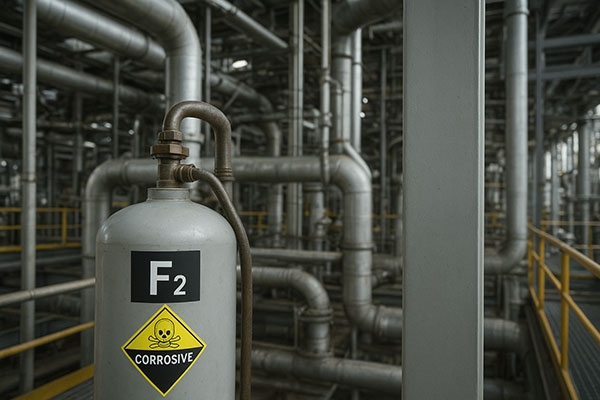Fluorine (F2) is a pale yellow gas with a strong, pungent odor, extremely toxic, and highly oxidizing. It belongs to the halogen group of the periodic table and is the most electronegative and chemically reactive element. At room temperature and pressure, Fluorine exists as a diatomic molecule (F2), consisting of two Fluorine atoms linked by a single bond. Due to its extreme reactivity, F2 reacts with almost all other elements, making it a highly dangerous yet industrially valuable gas. F2 does not exist naturally in its elemental form but rather as Fluorides (such as Calcium Fluoride, CaF2) in ores; therefore, it must be artificially produced industrially. Furthermore, due to its extremely high toxicity, gas detectors & monitors must be used during production and used to ensure personnel safety.
F2 gas can react with almost all elements to form various Fluorides, such as Hydrogen Fluoride (HF), metal Fluorides, and Carbon Tetrafluoride (CF4). Due to its strong oxidizing and corrosive properties, F2 gas is often used to prepare fluorochemicals, fluoropolymers, electronic materials, and nuclear energy materials.

Hazards of Fluorine Gas
F2 gas is a highly corrosive and toxic gas; inhalation or contact can cause serious harm.
Main Routes of Exposure
- Inhalation: Irritates the nose, throat, and lungs, causing coughing, chest tightness, and difficulty breathing;
- Skin Contact: Reacts with moisture on the skin surface to form Hydrogen Fluoride, causing deep chemical burns;
- Eye Contact: Can cause severe pain and even blindness;
- Ingestion: Extremely dangerous, may cause burns to the digestive tract and poisoning.
Toxicity Level
| Concentration | Harmful Manifestations |
| 0.1 ppm~1 ppm | Irritating odor, mild discomfort |
| 1 ppm~5 ppm | Eye, nose, and throat irritation |
| 10ppm | Immediate coughing and difficulty breathing |
| >25 ppm | Lung tissue damage, edema |
| >100 ppm | Can be fatal in a short period of time |
Prolonged exposure can lead to Fluorosis (skeletal Fluorosis), causing bone deformities, dental plaque, and respiratory damage. Therefore, Fluorosis detection and alarm devices must be installed in any location where F2 gas is used to prevent leaks.
Why are F2 gas detectors needed?
- The gas itself is difficult to detect: Although Fluorine gas has an irritating odor, it is almost undetectable by smell at low concentrations. By the time it is detected, the concentration is already close to dangerous levels.
- It reacts readily with air: F2 reacts with moisture in the air to produce Hydrogen Fluoride (HF) and Oxygen. These products are also highly corrosive and toxic.
- High risk of leakage: Aging or poorly sealed Fluorine gas pipelines can lead to chronic leaks, requiring real-time monitoring with a detector.
- Regulatory requirements: Occupational safety agencies (such as OSHA and NIOSH) have strict limits on Fluorine gas concentrations: OSHA limit: 0.1 ppm, NIOSH limit: 0.1 ppm (maximum).
Owning an F2 gas detector not only provides early warning and protects personnel safety but also helps companies comply with safety regulations.
Recommended GasDog Portable Fluorine (F2) Detector
| Model | GD200-F2 |
|
Gas |
Fluorine (F2) |
| Range | 0~1ppm, 0~10ppm |
| Resolution | 0.001ppm |
| Accuracy | ≤±3% F.S. |
| Explosion-proof Grade | Ⅱ 2G Ex ia Ⅱ CT4 Ga |
| Certification | CE, ATEX |
Fluorine (F2) is a highly oxidizing and toxic industrial gas widely used in Fluorine chemistry, electronics, nuclear energy, and polymer materials. Its importance is self-evident, but it is also an extremely dangerous gas. In production and laboratory environments, timely monitoring of Fluorine leaks is crucial for ensuring life and production safety. Equipping users with a high-precision and fast-response portable gas detector helps them monitor the F2 concentration in the environment in real time, preventing accidents, protecting personnel's health, and ensuring that the company meets safety standards.

